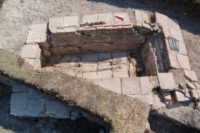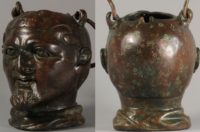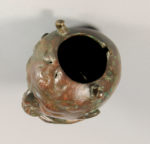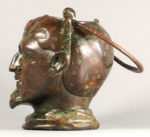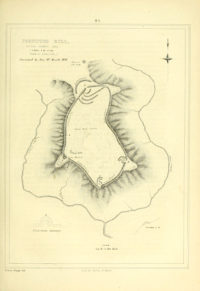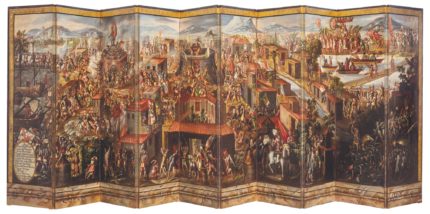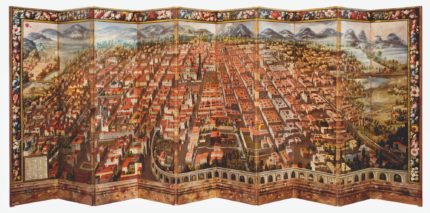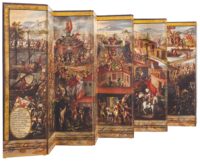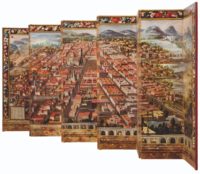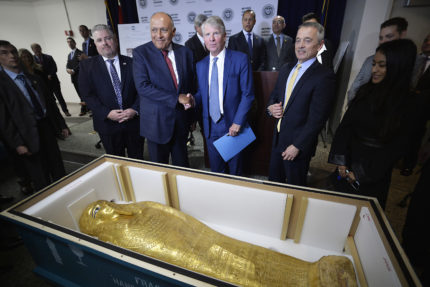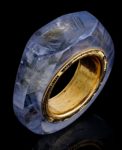 An ancient Roman sapphire ring once believed to have belonged to the Emperor Caligula is being sold by royal jewelers Wartski, best known as the foremost dealers and experts in the Fabergé Imperial Eggs and jewels after the fall of the Romanovs. It is an engraved sapphire hololith, meaning a ring carved from a single stone, with a gold band mounted on the inside, likely during the Middle Ages. The engraving is a left-facing profile of a beautiful woman believed to represent Caligula’s wife Caesonia.
An ancient Roman sapphire ring once believed to have belonged to the Emperor Caligula is being sold by royal jewelers Wartski, best known as the foremost dealers and experts in the Fabergé Imperial Eggs and jewels after the fall of the Romanovs. It is an engraved sapphire hololith, meaning a ring carved from a single stone, with a gold band mounted on the inside, likely during the Middle Ages. The engraving is a left-facing profile of a beautiful woman believed to represent Caligula’s wife Caesonia.
The ring was in the famed intaglio gemstone collection assembled by George Spencer, 4th Duke of Marlborough, in the second half of the 18th century. Before that, it was part of a smaller but also renown group of engraved gems collected by Thomas Howard, Earl of Arundel, in the first half of the 17th century. Via marriage and descent, Lord Arundel’s gemstone collection was added to the extremely fine pieces the Duke of Marlborough had bought from dealers and private owners on the continent.
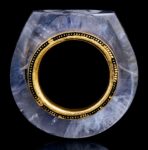 The Marlborough Gems, as the great collection became known, were sold by the 7th Duke, John Winston Spencer-Churchill, at auction in 1875 to raise money for the renovation of Blenheim Palace. Many of them were bought by David Bromilow, Esq, and then sold again by his daughter at an 1899 auction. The collection was thus broken up and dispersed — the Getty dropped major ducats on a dozen or so of them earlier this year — and there are Marlborough gems whose whereabouts are unknown today. This ring was one of them.
The Marlborough Gems, as the great collection became known, were sold by the 7th Duke, John Winston Spencer-Churchill, at auction in 1875 to raise money for the renovation of Blenheim Palace. Many of them were bought by David Bromilow, Esq, and then sold again by his daughter at an 1899 auction. The collection was thus broken up and dispersed — the Getty dropped major ducats on a dozen or so of them earlier this year — and there are Marlborough gems whose whereabouts are unknown today. This ring was one of them.
Sapphires, hyacinthus to the Romans, is a hard stone to carve and is very rarely seen in intaglios. Third century grammarian Gaius Julius Solinus describes it in his Polyhistor:
Among the things we have spoken of, the hyacinthus, which has a shining sky blue colour, is to be found. It is a valuable stone if discovered without blemish, for it is not a little subject to flaws. It is frequently either tempered with a violet colour, or covered with cloudiness, or softened to a white wateriness. The best type is not blunted by too solid a colour, nor over-clear with an eager transparency, but sweetly draws its bloom from both, dyed with the right proportions of light and purple. This stone perceives the winds and changes with the sky: it is not equally bright when the day is cloudy as when it is clear. In addition, the stone is colder when put into the mouth. It is certainly not suitable for carving, as it defies all grinding. Yet it is not utterly invincible; it can be scratched and inscribed by a diamond.
 Nowadays the deeper the blue, the more desirable the sapphire, but Solinus’ description of the most prized sapphires as a delicate balance of transparent, sky blue and light purple matches the color of the ring exactly. His comment also indicates that the extremely fine carving of the female profile on the ring had to have been done with a diamond. That’s how valuable and rare it was: diamonds were the tools used to make it.
Nowadays the deeper the blue, the more desirable the sapphire, but Solinus’ description of the most prized sapphires as a delicate balance of transparent, sky blue and light purple matches the color of the ring exactly. His comment also indicates that the extremely fine carving of the female profile on the ring had to have been done with a diamond. That’s how valuable and rare it was: diamonds were the tools used to make it.
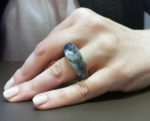 The hololith will be on display at Wartski in London from the 1st to the 7th of October, after which it will be available for sale. Wartski doesn’t do pre-sale estimates because they don’t want to scare off potential buyers, but it is in the neighborhood of £500,000 ($615,000).
The hololith will be on display at Wartski in London from the 1st to the 7th of October, after which it will be available for sale. Wartski doesn’t do pre-sale estimates because they don’t want to scare off potential buyers, but it is in the neighborhood of £500,000 ($615,000).
